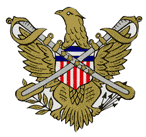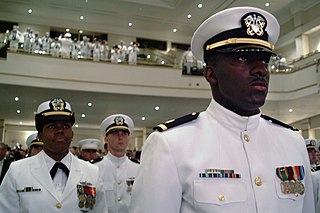
The Reserve Officers' Training Corps is a group of college- and university-based officer-training programs for training commissioned officers of the United States Armed Forces.

The Virginia Tech Corps of Cadets (VTCC) is the military component of the student body at Virginia Polytechnic Institute and State University. Cadets live together in residence halls, attend morning formation, wear a distinctive uniform, and receive an intensive military and leadership educational experience similar to that available at the United States service academies. The Corps of Cadets has existed from the founding of the Virginia Agricultural and Mechanical College in 1872 to the present-day institution of Virginia Tech, which is designated a senior military college by federal law. As of August 2021, about 1,200 cadets are currently enrolled in the program.

Exhibition drill is a variant of drill that involves complex marching sequences which usually deviate from drill used in the course of ordinary parades. Teams performing exhibition drill are often affiliated with military units, but the scope of exhibition drill is not limited to military drill teams. Exhibition drill is often performed by Armed Forces Precision Drill Teams, the drill teams at service academies and ROTC and JROTC units, and civilian drill teams that perform at parades, drill meets, and half-time shows and other public venues.

The Arnold Air Society (AAS) is a professional, honorary, service organization. AAS is open to officer candidates in Air Force Reserve Officer Training Corps (AFROTC) and at the United States Air Force Academy (USAFA), and is formally affiliated with the Air Force Association (AFA). In addition to AFROTC or Academy commitments, AAS members must complete candidate training, attend meetings, and contribute to their respective Squadrons and ROTC detachments. Doing so enhances the officer candidate experience of cadets as well as builds stronger leadership, organizational, and professional skills.

Beta Gamma Sigma (ΒΓΣ) is an international business honor society. Founded in 1913 at the University of Wisconsin, University of Illinois and the University of California, it has over 980,000 members, selected from more than 600 collegiate chapters in business schools accredited by AACSB International. It has collegiate chapters in over 190 countries.
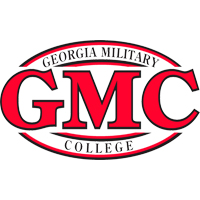
Georgia Military College (GMC) is a public military junior college in Milledgeville, Georgia. It is divided into the junior college, a military junior college program, high school, middle school, and elementary school. It was originally known as Middle Georgia Military and Agricultural College, until 1900. While GMC is a state-chartered and funded institution, its governance is not overseen by either the Board of Regents of the University System of Georgia or the State Board of the Technical College System of Georgia.

John E. Davis was an American politician who served as Director of the Defense Civil Preparedness Agency from 1969 to 1976. He also previously served as the National Commander of The American Legion, from 1966 to 1967, and as the 25th Governor of North Dakota from 1957 to 1961.
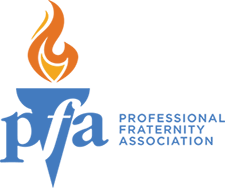
The Professional Fraternity Association (PFA) is an American association of national, collegiate, professional fraternities and sororities that was formed in 1978. Since PFA groups are discipline-specific, members join while pursuing graduate degrees as well as undergraduate degrees. PFA groups seek to develop their members professionally in addition to the social development commonly associated with Panhellenic fraternities. Membership requirements of the PFA are broad enough to include groups that do not recruit new members from a single professional discipline. The PFA has welcomed service and honor fraternities as members; however, Greek letter honor societies more commonly belong to the Association of College Honor Societies.

The Penn State Army Reserve Officers' Training Corps is the ROTC department at The Pennsylvania State University. It is the largest branch of the ROTC program at the school, which also has Naval ROTC and Air Force ROTC. The Nittany Lion Battalion (NLB) is one of the 41 participating battalions in the 2nd Reserve Officers' Training Corps Brigade, also known as the Freedom Brigade. The brigade is headquartered at Fort Dix, NJ, and comprises ROTC programs in the North Eastern United States including CT, MA, ME, NH, NJ, NY, PA, RI, and VT.
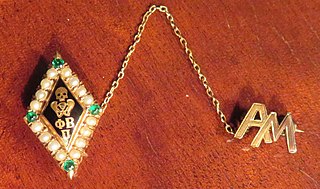
Phi Beta Pi (ΦΒΠ) is an American professional fraternity for medical students that was founded in 1891 at the West Pennsylvania Medical College. Currently, the fraternity operates in Galveston, Texas at the University of Texas Medical Branch at Galveston (UTMB).
The National Defense Cadet Corps (NDCC) was the forerunner to the current Junior Reserve Officers' Training Corps (JROTC) program and is essentially identical to it with just one exception: The NDCC is funded internally by the schools that opt for a military training system like JROTC but without any financial assistance from the Department of Defense. Therefore, the schools bear all costs associated with the program, including military instructor salaries, uniforms, training materials, and any other program expenses. As of 2012, there were three remaining US Army NDCC units in the United States. The US Navy began its program in April 2011. The US Marine Corps and the US Air Force also operate NDCC programs.

The Army Reserve Officer Training Corps (AROTC) is the United States Army component of the Reserve Officers' Training Corps. It is the largest Reserve Officer Training Corps (ROTC) program which is a group of college and university-based officer training programs for training commissioned officers for the United States Army and its reserves components: the Army Reserves and the Army National Guard. There are over 30,000 Army ROTC cadets enrolled in 274 ROTC programs at major universities throughout the United States. These schools are categorized as Military Colleges (MC), Military Junior Colleges (MJC) and Civilian Colleges (CC).
Reserve Officers' Training Corps in South Korea is a college-based officer training program which was established in 1961. South Korea's Conscription Law applies to males, aged between 18 and 35, although women are allowed to enroll in the ROTC as of 2010.

The Junior Reserve Officers' Training Corps is a federal program sponsored by the United States Armed Forces in high schools and also in some middle schools across the United States and at US military bases across the world. The program was originally created as part of the National Defense Act of 1916 and later expanded under the 1964 ROTC Vitalization Act.
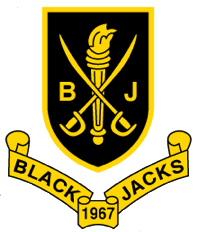
The National Society of Blackjacks is a High School Junior Reserve Officer Training Corps leadership program based on the example of General of the Armies John J. Pershing. The Blackjacks are the high school auxiliary of the National Society of Pershing Rifles.
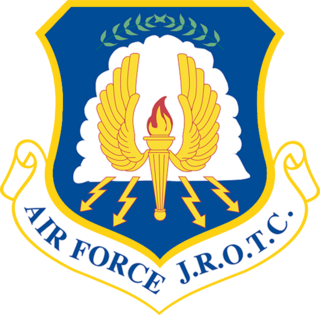
Air Force Junior Reserve Officers' Training Corps (AFJROTC) is an elective class offered in many high schools across the United States. It is the junior division of a U.S. Air Force Reserve Officers' Training Corps (ROTC) program composed of physical training, aerospace science academic classes, and leadership skill creation. Outside of the formal class, there are extra-curricular teams that cadets may participate in to create qualities of leadership and followership. Unlike the collegiate version of ROTC, upon completion of JROTC there is no military service required. This allows the youth of the United States to experience the military without having long-term commitments.

Pi Omega Pi (ΠΩΠ) is an American scholastic honor society recognizing academic achievement among students in the field of business education.
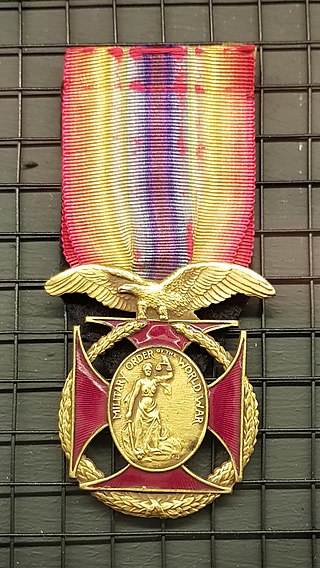
The Military Order of the World War was created in 1919 at the suggestion of General of the Armies John J. Pershing as a fraternity for American military officers coming out of the Great War. Two decades later, when the USA became involved in WWII the organization name was pluralized to its current title of Military Order of the World Wars. Though the Order's title has not changed since 1945, it remains an officers’ society welcoming new qualified members in current military service, retired military service, or former military service and has members from the Korean War, Vietnam War, Gulf War, War in Afghanistan, War in Iraq, and peacetime service.

Cannon and Castle is a military honor society founded at Yale University in 1929. Elected members include cadets and midshipmen from all three Reserve Officer Training Corps branches, active-duty servicemembers, veterans and faculty of the Yale community.
